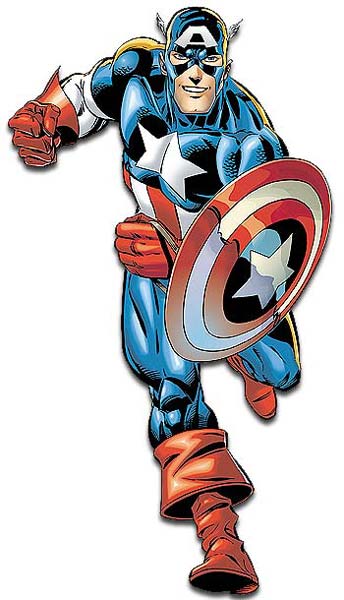Thursday, March 29, 2007
Olaf Lipro's Polo Flair
Also from the same site, the Top 10 Worst April Fool's Day Hoaxes. Just in time to inspire you for Sunday.
Today's topic stolen from Mark Evanier.
Wednesday, March 28, 2007
Empathy and Characterization
I got an inkling of that in Mom's Cancer when I received e-mails from readers saying that although they'd gone through completely different events with entirely different people, it was as if I'd been spying on their lives. None of the details were the same, yet somehow the overall story was true. They reconciled the differences ("Gee, except for the mother, the son, the daughters and the disease, this is just like us!") and, in a very real sense, became participants in the story.
(Incidentally, that's one reason my editor and I decided not to put a family photo on the back cover of Mom's Cancer. As cartoon characters, we were abstract representations--mother, son, daughters--that readers could map to their own lives. We thought showing our real selves might break that spell.)
Any time a book, song, poem, movie, television program makes me feel something, I try to go back and dissect how it did it. With respect to cartooning, I'm especially interested and impressed when I'm moved economically, with a minimum of words and pictures. I think this is a skill at which Charles Schulz, for example, excelled: within a few panels we not only knew a character but cared about him. I'm still trying to figure out how that magic trick works. Some examples from different media:
Example 1: Here's the very first Calvin & Hobbes comic strip by Bill Watterson:
 Those four panels deliver a lot. Not only do you immediately get to know and like Calvin, his father, and Hobbes, but you're also dumped into Calvin's first pith-helmeted adventure. You want to find out what happens next. And it's funny! One of the great things that Watterson did very well was design his strip and premise so that a new reader could walk into it almost anywhere and very quickly understand the characters and their relationships.
Those four panels deliver a lot. Not only do you immediately get to know and like Calvin, his father, and Hobbes, but you're also dumped into Calvin's first pith-helmeted adventure. You want to find out what happens next. And it's funny! One of the great things that Watterson did very well was design his strip and premise so that a new reader could walk into it almost anywhere and very quickly understand the characters and their relationships.
Example 2: I recently heard the Gordon Lightfoot song "Wreck of the Edmund Fitzgerald," in which a lyric goes:
When suppertime came the old cook came on deck
Saying "Fellas it's too rough to feed you."
At seven p.m. a main hatchway caved in,
He said, "Fellas it's been good to know you."
Lightfoot doesn't tell us the old cook's name or what he looks like. But can't you just see him? Don't you care about what happens to him? In less than three dozen words, Lightfoot painted a portrait of a steadfast seaman who worked below decks all his life, did his job through a lot of close scrapes, and now faces his perhaps not unexpected fate with calm courage and wit (and see how that's the content I bring to the song as the listener?). I love the old cook, and I don't think the song would be half as effective or haunting without him.
Example 3: Luxo Jr. is a character in one of Pixar's earliest movies, a 1986 short film that marked John Lasseter's directorial debut. Meant partly to show off the capabilities of that new-fangled computer animation, the film has no dialogue yet still conveys a charming story about young desk lamp Luxo Jr. and his patient father (Luxo Sr., I suppose). Through their movement, interaction, and body language, they tell a touching tale with no words at all. The picture below is of literally nothing but two desk lamps shining on each other, but even without animation it very effectively conveys emotion and personality. We, the viewers, give it meaning.

Example 4: There's a possibly apocryphal story of Ernest Hemingway boasting in a bar that he could write a novel in six words. The challenge accepted, Hemingway penned:
Baby shoes for sale, never used.
Now, I won't quibble over whether that constitutes a novel. But as a lesson in immediately and economically drawing readers into a story and inviting them to fill in the blanks with details from their own lives, I don't know of better.
The trick is figuring out how to do it at will instead of maybe accidentally tripping over it once in a while.
.
Monday, March 26, 2007
Style Over Substance
I very much believe that good, clear writing equals good, clear thinking. Conversely, I believe that someone who can't clearly communicate an idea probably hasn't thought it through very well. If I were a freshman English teacher, I think the first thing I'd do is strip my students' prose of all the baroque ornamentation and sparkly tricks that smart kids think make for good writing (and successfully bamboozle teachers). I'd force them to explain themselves in short, simple, declarative sentences. Then I'd slowly introduce complexity, and finally--when they demonstrated they could form a coherent thought and express it so anyone could understand it--I'd allow them to fold in some quirks that might constitute an individual "style." Break the horse before hitching up the cart.
One of the fun parts of knowing and working with people who write for a living is talking about style. In a journalistic setting, editors and publishers often impose a house style so their publication speaks with a characteristic voice pitched for their readers. "Scientific American" doesn't read like "Readers Digest." They sound different in your head. Digging deeper into the weeds, publications often have stylebooks that set rules for using words, abbreviations, punctuation, acronyms, titles and honorifics, etc. Most newspapers use the Associated Press Stylebook as their Bible, while larger publications often have their own guidelines. Smaller publications sometimes draft lists of supplemental rules that apply to local issues, landmarks, businesses, and people. Then comes the best part: arguing about them.
What inspired this post was my discovery that a monthly newsletter titled "Style & Substance," intended for the internal use of Wall Street Journal editors and reporters, is available online. This is where people who make their living with words hash out how to use them, debating the difference between "try to" and "try and," the origin and usage of "trans fat" (it shouldn't be one word but is of course hyphenated when a compound modifier, e.g., "trans-fat oils"), and whether you should capitalize "iPod" or "eBay" if they happen to fall at the start of a sentence (yes). The newsletter also points out misdirected pronouns, disjointed appositives, and embarrassing blunders that appeared in the Wall Street Journal's own pages, which speaks well for its dedication to self improvement and helps writers who wouldn't make the same stupid mistakes as those fancy-pants WSJ reporters feel better about themselves.
A similar online resource I enjoy is "The Slot," a blog written by Bill Walsh, copy editor for The Washington Post. Walsh wrote two books, Lapsing into a Comma and The Elephants of Style, that are similar in content and tone (and, I believe Walsh snarkily argues, superior in content) to the surprise bestseller Eats, Shoots & Leaves. The "Sharp Points" section of Walsh's website offers short essays, while his infrequently updated blog provides briefer insights. He's a pretty thoughtful and witty guy.
The best of the rulemakers acknowledge the arbitrariness of laying down the law in a frontier as messy as language. You'd think the job would attract humorless by-the-book pedants, and it sometimes does, but more often they seem pretty good-natured and open-minded. In that respect, they remind me of scientists who realize they're using imperfect tools to craft rules that are good enough for now but may have to be changed later. They hunt a mobile prey.
I love this stuff.
.
Saturday, March 24, 2007
Librarians Like Otis and Raina
Otis is a terrific guy who takes the responsibility of writing and drawing stories aimed primarily at kids very seriously. Which is not to say that adults can't appreciate his work, too, but I think he approaches the youth market with a professionalism and respect that's increasingly rare. Same for Raina, whom I've met a few times and like tremendously. A lot of creators, particularly in the broader comics universe, seem embarrassed to write for kids. That's sad. If they knew what they were doing, they'd understand how rich, complex, challenging, rewarding, and important youth literature can be. I think Otis and Raina know what they're doing.
The other eight books on the ALA's Top 10 List of Graphic Novels for Youth are:
Bumperboy and the Loud, Loud Mountain by Debby Huey
Kampung Boy by Lat
Castle Waiting by Linda Medley (met her briefly, too, and her book is great)
Missouri Boy by Leland Myrick
The Legend of Hon Kil Dong: The Robin Hood of Korea by Anne Sibley O'Brien
To Dance: A Ballerina's Graphic Novel by Siena Cherson Siegel
Girl Stories by Lauren Weinstein
American Born Chinese by Gene Luen Yang (winner of many other honors, haven't had a chance to check it out yet but I will).
Congratulations to all the authors, but especially the ones I know.
.
Thursday, March 22, 2007
Deadlines
Here's a glimpse at my day job, which I don't write about very often. The project occupying most of my time right now is a 1200-page tome called the Underground Transmission Systems Reference Book. It's got about 40 authors from five or six countries, and if you're a utility anywhere in the world planning to bury a high-voltage electric cable, this is the book for you. Trust me, you cannot imagine the science and engineering know-how that goes into laying a wire in a trench. A friend of mine has been editing the book for about a year now and it's almost ready for publication; however, he had to go to Italy for a couple of weeks and asked me to step in and finish the job for him. Athough he got 98% of it done before he left, taking over a logistically challenging project involving several authors, three teams of graphic designers, and a highly technical topic I know little about when it's hurtling full speed toward a we-really-mean-it deadline has its challenges.
It also has its rewards. In addition to money--which I'm really earning this time--I get the pleasure of being suddenly, unexpectedly, harrowingly immersed in an unfamiliar subject and quickly learning enough about it to both discuss it with experts and explain it to laymen. I got the same satisfaction as a newspaper reporter a long time ago and a freelance writer more recently. It's what I find most interesting and fun about my writing career. Unfortunately, the knowledge I gain only seems to stick around long enough for me to complete the job. Ask me about underground transmission systems in a month and I'll give you a blank stare. I may not even recall doing the job (that's nearly true; I've had the unnerving experience of looking at published magazine articles I've written and having absolutely no memory of them). But right now... I am Mister Underground Cable.
It's more exciting than it sounds.
.
Tuesday, March 20, 2007
More on Jay Kennedy
My favorite quote about Jay in Tom's article is from artist Gary Panter: "He liked Reddy Kilowatt." Although really, what's not to like?

The online reaction to Jay's death has confirmed what I wrote before: although he wasn't a household name to readers and fans, he was tremendously respected and influential among cartoonists. Interestingly, my impression is that few people seemed to realize how widespread that respect and influence were until he was gone and everyone started comparing notes. "He was exceptionally kind, engaging, and generous to you, encouraging you to persevere when no one else gave you any sign of hope? Me, too!"
Tom's article is a fitting tribute that puts Jay's career into context and suggests how long-lived his legacy will be. I'm proud that a tiny, tiny part of his legacy includes me.
Friday, March 16, 2007
Jay Kennedy
Jay Kennedy, editor-in-chief for King Features Syndicate--a job that made him one of the most important people in the world of cartooning--sadly and unexpectedly died yesterday. He reportedly drowned while vacationing in Costa Rica.
I'm pretty stunned. A syndicate editor is the person to whom you mail samples of your comic strip when you want it to be published in newspapers, and for a long time I did that semi-regularly. Every year or two I'd develop a comic strip, put together a month's worth of samples, send them to the syndicates, and wait for the rejections to roll in. Usually it's a discouraging, dehumanizing, unrewarding process.
Jay was one of the few editors who took the time to provide notes and encouragement along with the rejections. I knew I was getting somewhere when his notes grew from a scribbled sentence to a few paragraphs to comments on the individual strips. Finally, I came up with an idea he really seemed to like, and we corresponded back and forth for months trying to shape it into something I could write and draw and he could sell. That idea eventually died, and I think the fault was mostly mine. Jay gave me the opportunity and I didn't know how to take advantage of it.
I since learned that this is a very common story cartoonists tell about Jay. Turns out he treated a lot of people with the same kindness, grace, and generosity of spirit--which actually makes me less special than I thought, but him more. The number of cartoonists who say "I persevered because of the encouragement I got from Jay Kennedy" is enormous.
At last summer's San Diego Comic-Con, I attended a panel featuring several syndicated cartoonists and afterward reintroduced myself to Brian Walker, who is a comics historian and writer in addition to his work on "Beetle Bailey" and "Hi and Lois," two strips originated by his father Mort. I'd met Brian at my book launch in New York, he remembered me (I'm always surprised when people remember me), and after we talked for a minute he gestured to the man standing next to him and asked me, "do you know Jay Kennedy?"
After years of imagining Mr. Kennedy ("call me Jay") as a giant of the industry, I was kind of shocked to meet a man much shorter than me who at first seemed very quiet, almost timid. I introduced myself, told him I'd written Mom's Cancer, which he'd read--his wife had recently died of leukemia, though I have no idea if that experience and reading my book coincided--and figured this was my chance to tell him what I'd always wanted to:
"You won't remember, it's been a long time, but I submitted work to you and it meant more than you'll ever know to get any feedback at all, let alone the kind of encouragement and respect you gave me. Thank you."
And in fact he did still remember my work, said he'd always liked it and was sorry it didn't work out, and we had such a great conversation that I'm afraid I rudely cut out Brian Walker, who kind of wandered off and I really hope doesn't remember me now.
I haven't tried to come up with a comic strip for a long time--just haven't had any good ideas--but always in the back of my mind was the germ of a notion that I'd give it another shot someday and, when I did, Jay would be there to read it. I'm sad that will never happen and very glad I took the opportunity to thank him when I did.
.
Thursday, March 15, 2007
Best Day of My Life
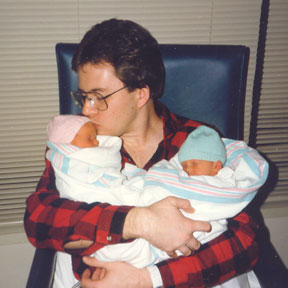
That's an armful. Somehow in the intervening years my hair has gone gray; I can't imagine why. Happy Birthday, Chiquitas, we'll see you this afternoon. Pizza's on Mom and me.
way of explaining what may count in rearing children:
your children are either the center of your
life or they're not, and the rest is commentary.
Wednesday, March 14, 2007
Joe and Monkey, Zip and Li'l Bit, plus a Review
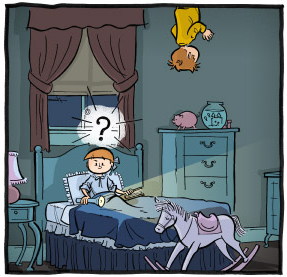
Zip (on ceiling) and Li'l Bit begin the
adventure of "Upside-Down Me" by Trade Loeffler
Monday, March 12, 2007
The Lulu Blooker Prize
The Blooker is awarded in three categories: fiction, non-fiction, and comics. There is prize money involved. Early this morning, the Blooker organizers announced the short list of nominees in each category and, well, I probably wouldn't be writing about it if Mom's Cancer weren't one of them. This is a really nice recognition that I appreciate very much.
The judges are writer/teacher/journalist Paul Jones, Arianna Huffington, the aforementioned Julie Powell, philosopher/writer Rohit Gupta, and journalist Nick Cohen. After I talk my publisher into sending them enough books for everybody to read without sharing ("Hey Arianna, hand that over, it's my turn!"), the judges will think it over and announce the three category winners and one grand prize winner on May 14.
My fellow nominees in the Comics category are Zach Miller for The Definition of Awesome: Another Joe and Monkey Collection, and Pete Abrams for Born of Nifty: Sluggy Freelance Megatome 01. I confess I'm completely ignorant of "Joe and Monkey." However, "Sluggy Freelance" is a genuine Webcomic success story and pioneer, a real model for creators trying to figure out how to build an audience and maybe earn a few bucks with Web-based content. ("Joe and Monkey" may be all those things, too; I just don't know about it.)
A measure of Pete Abrams's success? One gracious mention on his site less than 12 hours ago has brought more visitors to my site and blog than I'd normally get in about two weeks. Now that's an audience! Thanks for the hits, Pete, and good luck to you. Same to Zach.
Saturday, March 10, 2007
Strange Old Worlds
.
Kids, the 1960s were fun but they're over. Just Say No.
Then, following a trail of comments on that video, I found this on my own. From German television:
.
You know, that last one is obviously a spoof, but if you don't get a little chill when the orchestra plays those first four notes and the French horn fires up, I'll be nice to you but I'm afraid we can never truly be friends.
Slightly more seriously, I love the fact that a contemporary audience in Germany can hear the opening of a 40-year-old American TV theme song and roar in appreciative recognition. That's the definition of "iconic."
March 12 Addition: I remembered seeing the video below a while ago but didn't look for it until this morning. For the past several months, Paramount has been redoing the special effects for the original Star Trek and broadcasting the results, often buried on obscure channels in the late night or early morning hours. Fans seem divided on the results--with a few quibbles I think they've been very respectful and successful. At any rate, as part of the refurbishing, they re-recorded the Star Trek theme song, which is what the 1 minute and 27 seconds below is about:
.
And that's all I'll have to say about Star Trek for a while.
Thursday, March 08, 2007
R.I.P. Captain America
News Item (AP): Captain America has undertaken his last mission--at least for now.
The venerable superhero is killed in the issue of his namesake comic that hit stands Wednesday, the New York Daily News reported. On the new edition's pages, a sniper shoots down the shield-wielding hero as he leaves a courthouse.
It ends a long run for the stars-and-stripes-wearing character, created in 1941. Over the years, some 210 million copies of Captain America comic books, published by New York-based Marvel Entertainment Inc., have been sold in 75 countries....
This is news? Doesn't anyone remember when DC killed Superman a few years ago? Or Robin? They got better; so will Captain America.
This non-event nevertheless coalesces some thoughts about comic books, which I read and collected quite passionately between the ages of about 5 and 25, but turned away from in the late 1980s and haven't bought since. The obvious conclusion is that I outgrew them, but I never thought that was the case. Rather, I always felt like comic books turned away from me. They stopped being about the adventures of characters I loved. Their creators showed no appreciation for my loyalty or my business, so they lost me. When I realized I was only buying comics to keep my collection current and throwing them on a pile unread, I walked away with no regret.
What happened to comic books? They became grim and gritty, cynical and nihlistic. Trying to be more "mature," "adult,"and "realistic," their creators loaded them with depressing sex and violence--seldom handled in a way that a mature adult would recognize as realistic--while at the same time cutting our heroes from their moral underpinnings. Good guys became killers, then murderers, then mass murderers. Hopelessly square characters like Superman and, yes, Captain America were derided as old-fashioned Boy Scouts (take a moment to reflect on the perspective of comic book creators who use "Boy Scout" as an insult).
What they lost was the fundamental understanding that superheroes are adolescent wish fulfillment characters who are by definition better than us. They do things people in real life wouldn't or couldn't do--that's the "hero" part of superhero--and provide examples that in some small way we might emulate. When I was a child, they taught me concepts of courage, justice, resourcefulness, determination, and selflessness that were integrated into the foundation of my personality. I'm not attempting to be funny or disrespectful when I say that the Lone Ranger, Batman and Captain America were as important as my family in making the younger me want to become a good person who tries to do the right thing.
From the 1940s through the '70s, comics creators were professionals producing the best juvenile literature they could. The best of them, such as Julius Schwartz, Stan Lee, and Jack Kirby, added layers of meaning that more sophisticated adult readers also appreciated, but they knew who their audience was. Since then, I think a few unfortunate things happened. Kids who grew up on those comics wanted their favorite characters to grow up with them--to get older, have sex, battle existential depression, and shove samurai swords through each other's guts. Unfortunately, many of those fans became pros in a position to do something about it. Naturally bored with the heroes and adventures that had so successfully entertained them when they were young, they made stories to entertain their older, too-cool-for-school, cynical selves. "Hero? There's no such thing. Everybody's screwed up and looking out for Number One." They couldn't imagine anyone living to a more heroic standard than they did.
The old guard was proud to produce good juvenile fiction; too many of the new guys were embarrassed by it. At the same time, the comic book business shrank dramatically, so that today's creators are working for a smaller and smaller group of increasingly older fans who value the same things they do. One sad consequence is that there are very few comics produced in the last 20 years I'd be comfortable handing to an 8 year old (please don't send me a list; I realize there are exceptions and I don't currently know any 8 year olds). Another sad consequence is that a kid coming out of a recent movie featuring Superman, Batman, Spider-Man, the X-Men, or The Fantastic Four--generally depicted in their "classic" incarnations defined at the height of their popularity decades ago--would find nothing on the comics rack resembling those film heroes. What a lost opportunity!
(I feel duty-bound to say I'm not objecting to comics for adults. I wrote one. Comics are a medium that I truly believe can handle any mature themes and characters their creators can conceive, including sex and violence. If I have any complaint, it's that too few "adult" comics aspire to actual maturity. What I'm bemoaning is the misguided drive to shove that content into the pages of Superman. To shift genres, I wouldn't be happy to see the Hardy Boys fishing bloated corpses out of the river and getting into gun battles with drug-running rapists, either.)
See, the thing about Captain America is that he really has no superpowers. He was a scrawny kid during World War II who volunteered for an experiment designed to produce an American super-soldier. The treatment (think super-steroids) gave young Steve Rogers a perfect physique and the acrobatic skills of an Olympic gymnast. With such relatively meager abilities, Captain America went on to lead the Greatest Generation in The Last Good War. When Marvel Comics revived him in the 1960s, he became something more: the embodiment of the American ideal. Liberty, opportunity, the triumph of the ordinary man, all the good stuff about us that we hardly ever live up to but hope we can. At the same time, Captain America became the one man you'd follow into a fight because you knew he'd never give up and always find a way to win. Over the years, with hardly any superhuman abilities at all, Captain America grew into the respected moral center of the Marvel Universe. You could never go wrong asking, "What would Captain America do?"
Captain America won't stay dead. But, y'know, he might be better off if he did.
Wednesday, March 07, 2007
Gracias, Kibix
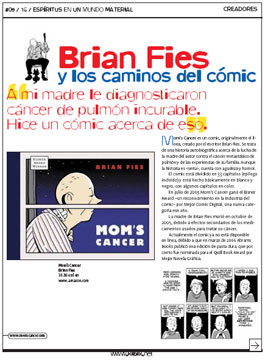

My impression is that Kibix is aimed at the same cohort that Nickelodeon reaches elsewhere, and I also gather that this "Creators" ("Creadores") section is a regular feature of the magazine. Other features touch on health, ecology, and so on.
A couple of things about this recognition strike me as interesting. First, there's no Spanish translation of Mom's Cancer on the market yet, so I'm especially pleased--if a little puzzled--that a Spanish-language magazine would feature it. Second, as I've written before, I'm bemused to see my book getting some notice as literature for children and young adults. I wasn't aiming for that.
However, I was very careful to write and draw Mom's Cancer so it'd be accessible to the widest audience possible, from children to grandparents who'd never read a comic book or graphic novel. I made choices in language and artistic style with that priority in mind. (Maybe someday I'll share the extraordinary profanity Mom was capable of that didn't make it into the book.) It's really nice to see that those choices worked, even if in a way I didn't intend.
.
Tuesday, March 06, 2007
Originals Shmoriginals
The nice folks at the Norman Rockwell Museum e-mailed me a wish list of the original art from Mom's Cancer they'd like to include in their "LitGraphic" exhibition, which opens this November. I was sorry to inform them that, of the eight pages they requested, four of them suffered from a minor problem called "not actually existing."
I am a proud cartooning dinosaur, drawing with brush, pen, ink, and a strong aesthetic that if paper was good enough for McCay, Kelly and Schulz then, by Zeus, it's good enough for me. But something I noticed in the many months it took me to draw (and live through) Mom's Cancer was how my relationship with digital art--specifically Photoshop--grew and evolved in that time. For example, on Page 10 of my book, I drew a picture of Mom metaphorically drowning in a sea of medical jargon.
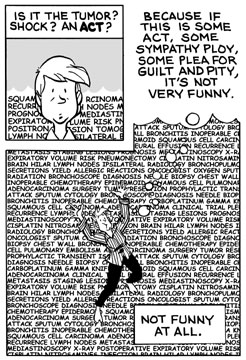
Now, I actually did that: the jargon was printed onto a sheet of paper that I carefully trimmed to size, glued to my two-ply bristol board, and painstakingly cut around the shapes of Mom, the waves, the bubbles, and the caption. That's what the original looks like.
.
But that's insane! The way to do that panel right (which is to say, the way I would've done it six months later or today) is to create Mom, the jargon, the captions, and the bubbles as separate elements and then layer them atop each other in Photoshop. It'd take one-twentieth the time and look much better. The only downside is that there'd be no original ... just scattered bits and pieces, half of them ephemeral electrons on a hard drive.
I'd regret that. But I'd still do it. Sometimes it's nearly unavoidable. For example....
One of the originals the Rockwell people asked for was the two-panel image of Mom on Page 47 that we also adapted for the cover. Now, Mom's Cancer began life as a Webcomic. Here's how that original looked:
A year later, Abrams agreed to publish Mom's Cancer and Editor Charlie picked this image as the one he wanted for the cover. Two problems: I needed to get rid of the captions--which meant I had to draw what was hidden "behind" them--and I frankly thought I could draw it better. Best to start from scratch. So I drew this: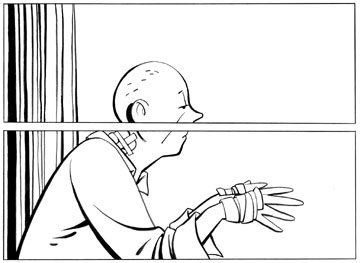
Obviously the captions are gone. The large space to Mom's right that I inked black in the first version is now blank, to be filled with color as we choose. And there are also no stripes on Mom's shirt. I wasn't sure we'd want the stripes for the cover and I was thinking about trying some fancy color separation stuff so, using a light box to trace over the drawing above, I drew those on a separate sheet of paper: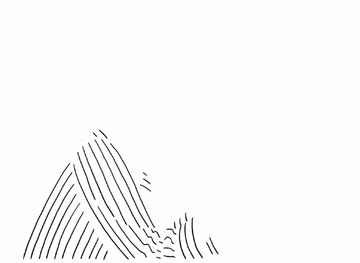
Then, combining the new drawing of Mom with the separate stripes and captions cut-and-pasted from the Web original gave me the published Page 47:
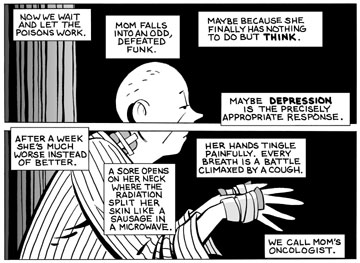 Combining the same elements differently, cropping, and adding color gave me a book cover. The only thing this process didn't give me was, again, an original that looks like either Page 47 or the cover.
Combining the same elements differently, cropping, and adding color gave me a book cover. The only thing this process didn't give me was, again, an original that looks like either Page 47 or the cover.
There's a tiny subsequent irony. When we were getting ready for my book's debut, Abrams wanted to make buttons using Mom's profile. The problem was that in my new art, I'd still drawn her with a panel gutter bisecting her head. So for the button graphic I had to digitally erase the panel borders and fill in the missing details. If I'd been smart, I would've drawn it without the panels in the first place. Yet another non-existent original.
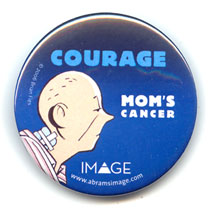 As I say, I'm not entirely happy about this state of things. Original cartoon art is very, very cool and I've always gotten both pleasure and education from studying it. I'm afraid we'll have volumes of great original hand-crafted art from the 19th and 20th centuries that will last forever and then nothing from the 21st century onward, as more and more of it is done digitally on media that won't survive a couple of decades (anybody got a 5.25-inch floppy drive?). That's a great loss.
As I say, I'm not entirely happy about this state of things. Original cartoon art is very, very cool and I've always gotten both pleasure and education from studying it. I'm afraid we'll have volumes of great original hand-crafted art from the 19th and 20th centuries that will last forever and then nothing from the 21st century onward, as more and more of it is done digitally on media that won't survive a couple of decades (anybody got a 5.25-inch floppy drive?). That's a great loss.I think the best I can do is value hand-crafted physical artwork and continue to do as much of it as I practically can, within the bounds of modern reproduction requirements and sanity. Although I've become much more proficient with, and even dependent on, Photoshop, I'd much rather spend hours hunched over a drawing board than a computer monitor. Originals matter.
.
By the way, I gave the Rockwell Museum a good list of alternative pages that do exist. We'll see what they like.
.
Friday, March 02, 2007
Rachmaninov had Big Hands
I think three things made Schickele and Borge "work" comedically: first was the mix of highbrow and lowbrow in their performances--the juxtaposition of guys in tuxes making funny noises, doing slapstick, and not taking the sometimes grim world of classical music at all seriously. Second was the fact that, despite the fun, they were fine musicians with genuine respect and affection for the art they lampooned. Third, I suppose, was the sense among audience members that we were part of an in-group that got the gags; in retrospect, I'm sure that was a big part of their appeal to Teenage-Me (it's probably no coincidence that the same girl friend was a fellow Monty Python fan as well).
Which is my prelude to this YouTube clip, which introduced me to a couple of guys skillfully mining the same musical-comedy vein. It's only 2:39 long, and I guarantee at least a smile.

